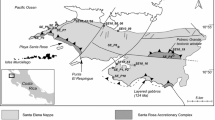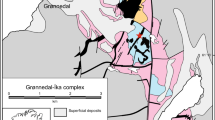Abstract
Stichtite, a rare (14 known localities worldwide) hydrated carbonate-hydroxide of Mg and Cr with ideal formula Mg6Cr2 (OH)16 CO3 · 4H2O, occurs exclusively in Cr-rich serpentinites of ophiolites or greenstone belts. Physical properties (hardness = 1.5–2, specific gravity = 2.16–2.2, perfect basal [0001] cleavage, grain size commonly < 100 μm) resemble talc, but the mineral has an attractive purple to lilac color; chemical analyses demonstrate it to be a non-silicate. Stichtite generally occurs as irregular to rounded masses (< 1 cm – 30 cm across) and as veinlets (< 1 mm – > 2 cm wide) within serpentinite. Macroscopic and microscopic textures, such as crosscutting veinlets and stringers, demonstrate that stichtite formation invariably post-dated serpentinization. In some specimens stichtite surrounds relict grains of Cr-rich spinel; in others stichtite has completely replaced euhedral or subhedral chromites. Chemical analyses of stichtites reveal substantial substitution of Al and Fe3+ for Cr in specimens from many localities, reflecting a possible compositional continuum between stichtite and rhombohedral polymorphs hydrotalcite (Mg6Al2 (OH)16 CO3 · 4H2O) and pyroaurite (Mg6Fe2 (OH)16 CO3 · 4H2O). We report the first electron microprobe analyses of stichtites from seven localities, and summarize all available published chemical data. Stichtites very likely inherited part of their trivalent cation chemistry from precursor Cr-rich spinels, but stichtite growth apparently post-dated characteristic “ferritchromit” alteration, as demonstrated by the depletion of Al and enrichment in Fe3+ in stichtite relative to primary chromite core compositions. Stichtite appears to form by reaction between serpentine and altered chromite, during addition of substantial fluid, either as separate H2O and CO2 phases, or as a mixed volatile phase. Such reactions must involve removal of substantial SiO2, possibly by transport and remote deposition of silica by throughgoing aqueous and carbonic fluid.
Similar content being viewed by others
Author information
Authors and Affiliations
Additional information
Received: 4 April 1996 / Accepted: 16 September 1996
Rights and permissions
About this article
Cite this article
Ashwal, L., Cairncross, B. Mineralogy and origin of stichtite in chromite-bearing serpentinites. Contrib Mineral Petrol 127, 75–86 (1997). https://doi.org/10.1007/s004100050266
Issue Date:
DOI: https://doi.org/10.1007/s004100050266




